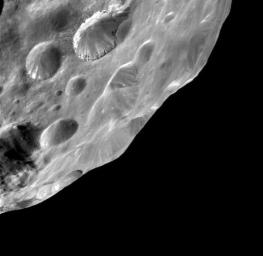
|
Phoebe’s Surprise
- Click the image above for a larger view
- Full-Res JPEG (1036 x 1009) (70.4 kB)
- Full-Res TIFF (1036 x 1009) (597.9 kB)
Caption:
Phoebe delivers on its promise to reveal new wonders to Cassini by showing probable evidence of an ice-rich body overlain with a thin layer of dark material. The sharply-defined crater at above center exhibits two or more layers of alternating bright and dark material. Imaging scientists on the Cassini mission have hypothesized that the layering might occur during the crater formation, when ejecta thrown out from the crater buries the pre-existing surface that was itself covered by a relatively thin, dark deposit over an icy mantle. The lower thin dark layer on the crater wall appears to define the base of the ejecta blanket. The ejecta blanket itself appears to be mantled by a more recent dark surface lag.
This image was obtained on June, 11 2004 at a phase, or Sun-Phoebe-spacecraft, angle of 79 degrees, and from a distance of 13,377 kilometers (8,314 miles). The image scale is approximately 80 meters (263 feet) per pixel. No enhancement was performed on this image.
Background Info:
The Cassini-Huygens mission is a cooperative project of NASA, the European Space Agency and the Italian Space Agency. The Jet Propulsion Laboratory, a division of the California Institute of Technology in Pasadena, manages the Cassini-Huygens mission for NASA's Office of Space Science, Washington, D.C. The Cassini orbiter and its two onboard cameras, were designed, developed and assembled at JPL. The imaging team is based at the Space Science Institute, Boulder, Colo.
For more information, about the Cassini-Huygens mission visit, http://saturn.jpl.nasa.gov and the Cassini imaging team home page, http://ciclops.org .
Cataloging Keywords:
| Name | Value | Additional Values |
|---|---|---|
| Target | Phoebe | |
| System | Saturn | |
| Target Type | Satellite | |
| Mission | Cassini-Huygens | |
| Instrument Host | Cassini Orbiter | |
| Host Type | Orbiter | |
| Instrument | Imaging Science Subsystem (ISS) | |
| Detector | ||
| Extra Keywords | Crater, Grayscale | |
| Acquisition Date | ||
| Release Date | 2004-06-13 | |
| Date in Caption | ||
| Image Credit | NASA/JPL/Space Science Institute | |
| Source | photojournal.jpl.nasa.gov/catalog/PIA06067 | |
| Identifier | PIA06067 | |
